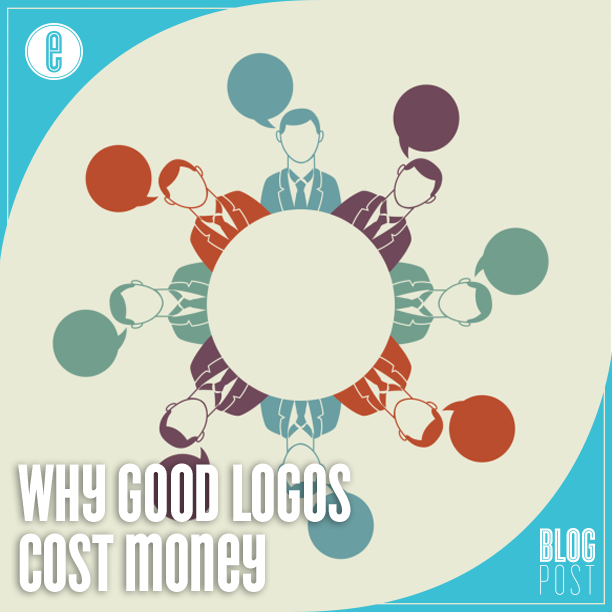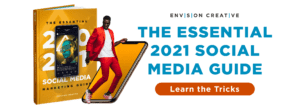
When you pay for a logo, you’re not just paying for the design—you’re also paying for the entire process of creating it. This includes meetings, drafting, revisions, and finalization. Because of this, it’s very important to choose your logo designer wisely in order to make the most out of your time and money spent. A “cheap” logo might seem appealing at first, but it’s more than likely a red flag that the quality won’t be there. (How does a serious $300 surgery sound to you? Yikes, right?)
Most of the expenses of logo creation are in the form of hourly wages. We’re not talking about just a single person—we’re talking about a whole design team’s hourly wages. Most of the time, a designer’s workday extends well beyond 8-hours—and even when the day is technically done and they’re not actively designing at their computer, they’re thinking about design (your design).
What are logos and why are they important?
Inexperienced business owners might think, “What’s the big deal? It’s just a logo.” Logos are the “face” companies show towards their clients and consumers. They represent a company’s professionalism, credibility, and integrity. If poorly designed, a logo will have lasting, negative effects on the company. So yes, they are a big deal.
Why does creating a logo take so long?
Depending on your target audience, the design of your logo may vary from straightforward and simple to nuanced and abstract. Either way, you want everything about your logo design to be deliberate—the font choice, the spacing, the shadows, the colors, and the list goes on and on. The best designers have reasoning behind every aspect of their design. With their talent, education, and experience, they’re perceptive to the subtleties that most of us aren’t. They’re not just working with “colors,” but with thousands of shades, and they know exactly why a particular shade of red is the right choice for the job. They’ll ruminate over moving an image ever-so-slightly to the right, because to their trained eyes, it makes all the difference. And in the end, it also makes all the difference to non-designers—though usually on an unconscious level that they can’t articulate. Good logos, even when they seem simple (or more often, especially when they seem simple) don’t happen by accident, don’t happen overnight, and don’t “happen” at all. They are the product of tons of brainstorming, specific intention, artful execution (involving lots of different media, special tools, and a mixture of design applications), and plenty of fine-tuning. Below we break down the whole design process so you can get an idea of what happens every step of the way.
1. Consultation
Your designer can’t conceptualize your logo without knowing anything about your company’s background and goals. During your consultation with the agency you’re working with (at Envision, we call it a Discovery Meeting), expect to be asked a lot of questions about your business. Understanding what your company does and the identity of your target audience is only a very basic part of it. An agency and its designers should have a strong sense of your aesthetic preferences, your company’s history, and the associations you want people to have with your company, starting with its logo. Once the designer and other involved parties have enough information, the next step begins.
2. Research
Even after the consultation, the designer and other people involved will (hopefully) continue to do research on your company, your industry, and the history and fundamentals of both. They’ll learn about your competitors and make sure your design is unique. Remember: if they’re doing their job well, a designer isn’t mindlessly creating a logo that merely “looks cool,” even though that’s part of it. They’re creating something that carries meaning, sends a message, and evokes a feeling.
3. Drafting
The design team (which includes one or more designers and everyone whose eyes are on the design and its process) will start creating drafts for your logo based on the information you gave and their own research. The designs may be similar to one another or very different, depending on how broad your target audience is.
4. Review and Revise
You’ll have a meeting with the design team where they present the logo options they’ve developed. Keep in mind that these are rough drafts for your feedback and critique. It’s your opportunity to share your thoughts on factors like color and font, whether the logo conveys what you want it to, and whether it speaks to the right audience. If you aren’t satisfied with any of the drafts and feel they don’t offer a basis to work from, be aware of the time that will go into creating entirely new drafts. After getting your feedback, the designers will craft revisions (or entirely new logos) for your review at a later date.
5. Finalization
Once you’ve found the one, the designer will give you versions of the logo to meet your needs for various formats, colors, and sizes, and adaptations for social media. You’ll also get a style guide, and whatever else is important to make the logo versatile for your business. At this point, the logo is yours.
The best logos require raw talent; the work, planning, and time of a whole team; and the money to support their expertise and effort. If you’re left a bit skeptical of the process and think “anyone” can a great logo, be prepared to handle the risks.
-FINAL(01-00)-White&Blue-01.svg)




